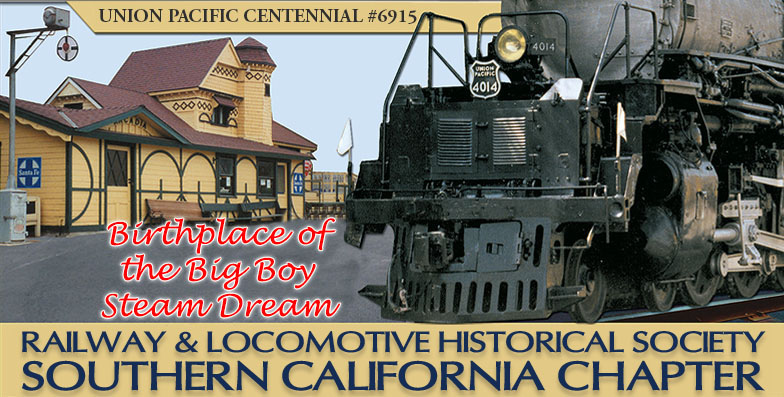Union Pacific “Centennial” 6915
A Brief History Of This Engine

The Union Pacific Centennial is the largest and most powerful diesel locomotive ever built. These locomotives were custom built for Union Pacific between 1969 and 1971 and named Centennials to commemorate the 100th anniversary of the ceremony driving “the last spike” completing the first transcontinental railroad at Promontory Summit, Utah Territory on May 10, 1869. (At that time, continuous rail lines connected Omaha and Sacramento, but railroad hadn’t connected Omaha with points east until several years later.) Centennials are fast-freight locomotives powered by two diesel engines, and are designated the DDA40X locomotive type.
Centennial locomotive number 6915 was built in October 1969 and was retired in 1984 having traveled over 950,000 miles. No. 6915 is one of 47 Centennials constructed, and is one of 14 Centennials existing today. Centennial no. 6936 is still in operation and based in Cheyenne, Wyoming. It is owned by Union Pacific and used on special event trains.
The Era Of The Diesel Electric Locomotive
Although diesel locomotives first came to American railroads in the 1920s, their use was confined to switch engines, and later to passenger train locomotives. It wasn’t until 1940 that the Electro-Motive Division of General Motors (EMD) demonstrated that diesels could practically replace steam locomotives in heavy-duty service. A pioneer freight diesel, model “FT,” toured the nation’s railroads and changed history. Much like its sister passenger locomotives of the day, it was styled with an automobile-like nose and windshield, a design that prevailed until the late 1950s.
Although commonly called “diesels,” the locomotives actually are electrically driven. The diesel engine drives a generator, which produces electricity to run electric motors mounted on the locomotive’s axles. The internal combustion engine was a dramatic improvement in efficiency over the steam locomotive, making substantial savings possible in maintenance and the elimination of widespread facilities. Extra units could be coupled together and run by one engineer from the lead unit, creating very powerful combinations.
Many railroads, including Union Pacific, were unable to take quick advantage of the new technology due to material shortages caused by World War II. Union Pacific’s fleet of modern steam locomotives and plentiful on-line coal reserves in Wyoming were another factor in UP’s late entry into the dieselization race. After the war however, railroads began sweeping the rails clear of the classic steamers. Union Pacific began its sweep in the late 1940s on the line running through the southwestern deserts, where water was difficult to obtain for steam engines.
![]() Click on the PDF icon to open your copy of our Union Pacific #6915 Brochure
Click on the PDF icon to open your copy of our Union Pacific #6915 Brochure




